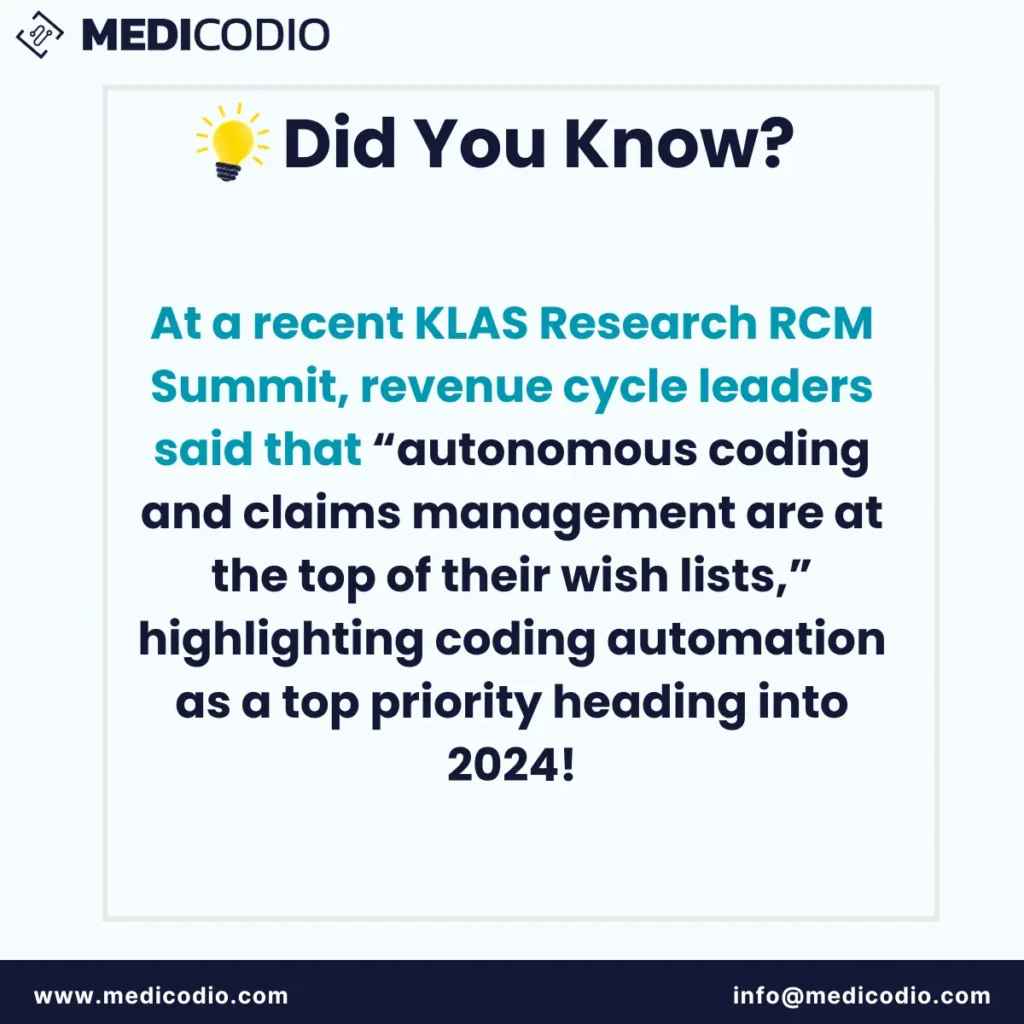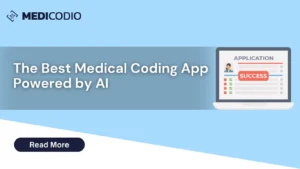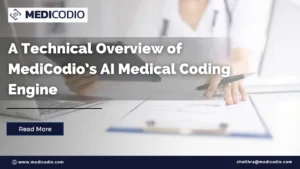The Scope
The healthcare industry faces a constant challenge: ensuring accurate and efficient medical coding. Manual coding processes are often time-consuming, prone to errors, and struggle to keep pace with the ever-growing volume of medical data. This white paper explores the transformative potential of Artificial Intelligence (AI medical coding). This concise exploration aims to provide stakeholders with a comprehensive understanding of the implications of AI medical coding, fostering informed decision-making within the dynamic intersection of artificial intelligence and the vital domain of medical coding.
The Purpose
Our aim with this whitepaper is to provide clarity on AI medical coding and assist RCM leaders and healthcare billing managers in making an informed decision on whether to implement AI-powered medical coding software. As per the CAQH 2020 index, automating Healthcare Administrative Transactions Has Reduced Annual Costs by $122 Billion, $16.3 Billion More Can Be Saved Through Further Automation.
1 Introduction
The US healthcare industry abides by the standardized medical codes for all medical services. This makes medical coding one of the crucial processes in the entire healthcare RCM journey. Currently, the ICD-10 has more than 68,000 diagnosis codes and more than 87,000 procedure codes in its coding system, making the system more precise and detailed than the previous systems.
Imagine the frantic scramble – medical reports piled high, deadlines looming, and the constant worry of a coding error leading to denied claims and financial strain. This is the daily reality for many medical coders, the unsung heroes who ensure healthcare facilities get reimbursed. Expecting medical coders to specialize in all these codes and all specialties is a far-fetched thought.
But what if there was a powerful ally, a tireless assistant who could slash coding errors, streamline the process, and free up coders to focus on what matters most – patient care?
This is where Artificial Intelligence (AI) can be a great partner for RCM Leaders and medical coders. AI medical coding tool acts as a valuable partner, assisting your coders in streamlining the process and improving accuracy. This frees them to leverage their expertise on the most challenging cases, ensuring the highest quality coding for your organization. But is it a friend or foe for medical coders? Buckle up, because this exploration of AI’s impact will unearth a world of possibilities, where both efficiency and expertise can thrive.
2. The Challenges
Medical coders encounter a multitude of challenges that significantly impact their daily operations. One major hurdle is the time-consuming process of manually downloading data, with the added stress of cross-checking to ensure that all necessary information has been accurately retrieved. This drains valuable time and introduces the risk of errors in the data retrieval process.
Moreover, medical coders face the daunting task of being well-versed in all specialties, even those they may have limited exposure to or lack real-world experience with. Even certified coders may find themselves grappling with unfamiliar specialties, leading to potential inaccuracies in coding.
The reliance on traditional code search methods, such as searching through books, proves time-consuming. Additionally, the high cost of code search software and the cumbersome process of swapping between multiple applications contribute to the challenges medical coders face.
Billing complexities further compound the issues, as coders may unknowingly bill services together that should not be billed on the same day by the same practitioner. This realization often comes only after the submission of claims, leading to rejections or reduced payments. Understanding and navigating National Correct Coding Initiative (NCCI) edits becomes crucial, as coders must identify and appropriately apply modifiers to override these edits.
The manual tracking of charge capture details daily adds another layer of challenge for coders, who must ensure accuracy and completeness. Meanwhile, coder managers or supervisors may lack insight into how coders are performing, tracking productivity, accuracy, and the number of pending charts.
Data entry, a time-consuming and unpleasant task, poses a risk of typographical errors that could have significant consequences. Complex specialties like Evaluation and Management (E&M), Surgery, and Invasive Vascular Radiology (IVR) demand intensive reading and understanding, consuming valuable time and manpower.
The process of finding accurate codes in line with coding guidelines is an experience-based activity, often causing delays for new coders. Coding complex documents is inherently challenging and further exacerbated by the intricate nature of certain medical procedures.
Ensuring compliance with Current Procedural Terminology (CPT) guidelines is paramount, with overlooking the Global Surgical Package (GSP) potentially resulting in substantial denials and revenue losses. The introduction of new rules in 2023 has replaced the old MDM level selection style, adding complexity to understanding and calculating risk levels.
In essence, medical coders grapple with a myriad of challenges ranging from time-consuming manual processes to the intricacies of accurate coding, making their work both demanding and critical to the healthcare system.
3. The History of Medical Coding
3.1 What is Medical Coding?
Medical coding is the process of converting healthcare diagnoses, procedures, and medical services into standard medical alphanumeric codes. These codes are derived from medical records, including physician’s notes, laboratory and radiology results, and other documentation. Medical coders play an important role in ensuring that the codes are applied accurately during the medical billing process. This involves extracting information from the documentation, assigning the appropriate codes, and creating a claim that can be submitted to insurance carriers for payment.
3.2 The Origin
The origin of medical coding can be traced back to the mid-20th century when the healthcare industry was grappling with the complexities of managing patient records and facilitating reimbursement processes. As medical practices and technologies advanced, the sheer volume of healthcare data became overwhelming, necessitating a systematic and efficient method of organization.
In the early 1960s, the American Medical Association (AMA) recognized the need for a standardized coding system. This realization led to the creation of the Current Procedural Terminology (CPT) in 1966 – a comprehensive code set designed to standardize medical procedures and services. The CPT system was initially developed to streamline communication among physicians, insurers, and other stakeholders in the healthcare ecosystem.
As the demand for a more comprehensive coding system grew, the World Health Organization (WHO) introduced the International Classification of Diseases (ICD). The ICD, first published in the mid-19th century, underwent several revisions, with the most notable being the ICD-10, which came into existence in the early 1990s. This system standardized the classification of diseases and health-related issues, providing a global framework for medical coding.
With the advent of technology, medical coding underwent a digital transformation. Electronic Health Records (EHRs) became increasingly prevalent, and the transition from manual coding to automated coding systems gained momentum. This shift not only expedited the coding process but also enhanced accuracy and reduced errors, thereby improving the overall quality of healthcare data.
Medical coding, once an essential but manual task performed by dedicated professionals, has evolved into a sophisticated discipline at the intersection of healthcare and information technology. Today, certified medical coders play a crucial role in ensuring accurate documentation, facilitating proper reimbursement, and supporting data-driven decision-making within the healthcare ecosystem.
What began as a response to the growing complexity of healthcare data has transformed into a cornerstone of modern healthcare administration, ensuring that the language of medicine is universally understood and efficiently communicated.
4. The Solution: The Role of AI Medical Coding
In the complicated world of healthcare, the quest for efficiency, accuracy, and scalability has spurred a growing interest in the integration of artificial intelligence (AI) and automation within the realm of medical coding. This narrative unfolds against a backdrop of burgeoning data volumes, the demand for streamlined processes, and the perpetual pursuit of enhancing patient care.
As the volume and complexity of healthcare data continue to surge, the traditional manual methods of medical coding face limitations in terms of speed and accuracy. The burgeoning need for a more dynamic solution prompted the industry to turn its gaze towards AI and automation, recognizing the potential to revolutionize the coding landscape.
AI, with its cognitive abilities and learning algorithms, presents a promising avenue for automating mundane and repetitive coding tasks. The ability of AI medical coding systems to analyze vast datasets and recognize intricate patterns facilitates a more efficient and accurate coding process. This not only expedites the turnaround time for coding tasks but also significantly reduces the risk of errors inherent in manual coding. According to the Council for Affordable Quality Healthcare (CAQH), the healthcare industry could save $9.8 billion annually by fully automating the Healthcare RCM Process.
One of the key drivers behind the industry’s pursuit of AI and automation is the potential to address the shortage of skilled human coders. The demand for accurate and timely coding outpaces the availability of qualified professionals, creating a workforce gap. AI-powered coding solutions serve as force multipliers, augmenting the capabilities of human coders and enabling them to focus on more complex and nuanced aspects of the coding process.
Moreover, the dynamic nature of healthcare regulations and coding guidelines necessitates constant adaptation. AI systems, equipped with machine learning capabilities, can swiftly evolve and incorporate updates, ensuring compliance with the latest coding standards. This adaptability reduces the regulatory burden on healthcare organizations and minimizes the risk of non-compliance.
The imperative for cost containment in healthcare further fuels the interest in AI and automation. Automated coding processes not only enhance efficiency but also contribute to cost savings by mitigating the need for extensive manual labor. The long-term financial benefits of reduced operational costs and improved revenue cycle management underscore the strategic importance of AI in the medical coding landscape.

5. Research Summary: AI Medical Coding
-
- According to Precedence Research, The global AI in medical coding market size reached USD 2,060 million by 2022 and is projected to hit around USD 7,150 million by 2032, expanding at a remarkable CAGR of 13.3% between 2023 and 2032.
- In April and September 2020, the World Health Organization introduced new ICD-10 codes, specifically addressing COVID-19 and telehealth-related issues. These additions reflected the dynamic nature of the healthcare landscape and emphasized the necessity for an adaptable coding system to address emerging health challenges.
- In 2022, according to NIH, the demand for AI in medical coding driven by the impact of COVID-19, is evident in the notable increase in its use in revenue cycle management. Introducing the new ICD-11 has enhanced flexibility and scalability, featuring approximately 55,000 codes to classify various health conditions. This revision supports Electronic Health Record (EHR) integration, aligning with the evolving landscape of healthcare information management.
- Healthcare finance leaders are excited about the new advancements in AI, particularly generative AI. According to a recent survey, almost half of CFOs (47%) plan to increase their technology implementation spending this year. The survey also revealed that nearly all respondents (98%) are currently piloting generative AI, while 46% are developing their own proprietary generative AI platform.
- According to the report, healthcare leaders’ satisfaction with the use of AI in RCM varies significantly by role. RCM decision-makers are the most satisfied, with 78% reporting satisfaction. However, only 25% of corporate leaders and 46% of IT leaders are satisfied with AI in the Healthcare Revenue Cycle.
6. Benefits of AI Medical Coding
As RCM leaders and healthcare billing managers seek reliable solutions to enhance operational efficiency, reduce costs, and minimize coding errors, AI medical coding presents a compelling solution.
The Boon of Efficiency:
AI medical coding promises a substantial reduction in manual coding efforts, offering an impressive 60-70% decrease in the time traditionally spent on coding tasks. This translates into a streamlined workflow, allowing medical coders to redirect their focus to more intricate aspects of the coding process, such as handling complex cases and ensuring accuracy in code assignments.
Mitigating Denials:
One of the persistent challenges faced by healthcare billing managers is the prevalence of coding denials, leading to revenue losses and increased administrative overhead. AI medical coding significantly mitigates this issue by introducing a level of precision and consistency that is challenging to achieve manually. Studies indicate a remarkable 60% reduction in coding denials, empowering healthcare providers to improve their revenue cycle and enhance financial sustainability.
Cost-Efficiency at its Core:
Implementing AI medical coding translates into substantial savings for healthcare organizations. With the ability to reduce coding efforts, organizations can anticipate a cost-saving of over 30%, contributing to a more efficient and financially sustainable RCM strategy. This not only aligns with the industry’s cost-conscious approach but also opens up opportunities for strategic investments in other critical areas of healthcare services.
A Surge in Productivity:
AI’s ability to swiftly process vast amounts of data surpasses human capabilities, resulting in a 45% increase in overall coding efficiency. Medical coders can focus on refining their expertise, addressing coding complexities, and contributing meaningfully to the healthcare billing process. The integration of AI complements human intelligence, creating a symbiotic relationship that enhances productivity across the entire coding spectrum.
Free Up Your Coders for Higher-Level Work:
Let AI handle the repetitive tasks. This allows your skilled coders to focus on areas that require human expertise, such as complex coding scenarios, auditing, and quality control. This not only improves overall accuracy but also boosts coder morale and job satisfaction.
Embracing the Future:
The integration of AI in medical coding is not a threat to the role of medical coders but a strategic evolution. It empowers coders to transcend mundane tasks, elevating their role to that of strategic advisors in the billing process. By embracing AI, healthcare organizations position themselves at the forefront of technological innovation, fostering a culture of adaptability and resilience.
Final Thoughts
In conclusion, while some may fear AI as a replacement for medical coders, the reality is far more optimistic. AI medical coding presents a powerful opportunity to elevate the profession. By automating routine tasks and minimizing errors, AI frees up coders to focus on complex cases and develop their critical thinking skills. This shift positions them as valuable clinical coding specialists, collaborating with AI to ensure accurate reimbursement and contribute to better healthcare delivery. Investing in AI medical coding isn’t just about efficiency; it’s about embracing innovation to empower the human expertise that remains irreplaceable at the heart of quality medical coding.
Don’t wait – explore AI medical coding solutions today and see how they can transform your RCM operation.
Have you tried CODIO?
At MediCodio, we have developed CODIO, a groundbreaking AI-based medical coding tool that will help RCM leaders and healthcare billing managers boost efficiency by 45%, increase accuracy by 85%, reduce coding denials by 60%, save on coding costs, and reduce turnaround time to under 24 hours.
If you are curious to know about AI medical coding too, schedule a demo with us for free.
Learn More about CODIO: Click here!





